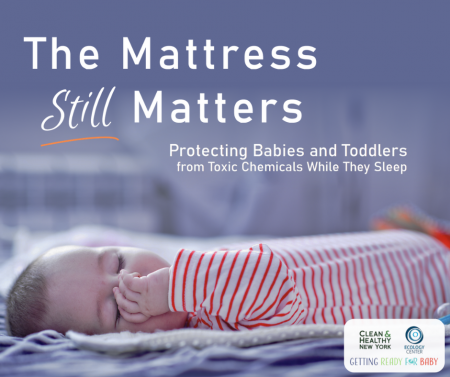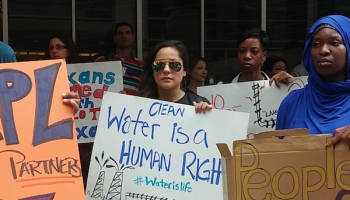Every parent knows that preparing for a new baby can be overwhelming. We do research to find the safest, best products with which to care for them. Between the diapers, bibs, nursing pillows, onesies, car seat, stroller, bottles, ointment, etc. it can be easy to miss researching crib mattresses. But, one of the most important purchases a family can make is the crib mattress.
 A new report, The Mattress Still Matters, released by the Ecology Center and the Getting Ready for Baby (GRfB) campaign makes it easier for parents to make an educated choice about crib mattresses. The Mattress Still Matters contains comprehensive research on 227 crib mattresses, test results from a subset of 13 mattresses, and a comparison chart to examine company transparency. GRfB scoured the Internet and surveyed 37 companies to compile publicly-available data. At the Ecology Center Healthy Stuff lab, we tested 103 crib mattress components for materials and chemicals like fire retardants, plasticizers, and PFAS.
A new report, The Mattress Still Matters, released by the Ecology Center and the Getting Ready for Baby (GRfB) campaign makes it easier for parents to make an educated choice about crib mattresses. The Mattress Still Matters contains comprehensive research on 227 crib mattresses, test results from a subset of 13 mattresses, and a comparison chart to examine company transparency. GRfB scoured the Internet and surveyed 37 companies to compile publicly-available data. At the Ecology Center Healthy Stuff lab, we tested 103 crib mattress components for materials and chemicals like fire retardants, plasticizers, and PFAS.
Our infants and young children sleep for the better part of the day. And most of that time, they are sleeping on crib mattresses. Babies do not sleep with pillows. Their faces rest directly on the sheet-covered mattress. As they sleep, they breathe deeply. Sometimes they sweat and sometimes they drool, increasing contact with their sleep surface. As a parent, I want to know what my little ones are sleeping on, breathing in, and possibly absorbing.
When shopping for a new crib mattress, we may be drawn in by attractive terms, such as “natural,” “ecofriendly,” “organic,” “sustainable,” or “nontoxic.” Promises of “soyfoam” or “infused with plant oil” or “plant-based foam” may distract us from the fact that the product still contains polyurethane (PU) foam, a problematic petroleum product.
Unfortunately, the labels of crib mattresses (unlike food and cosmetic labels) often don’t give us the full list of materials/ ingredients the product contains. They don’t have to because the law does not require it. That’s where we come in. In our Healthy Stuff lab we deconstruct and test everyday items to find out what’s in them.
We have been testing everyday household items for toxic chemicals and reporting on the findings for 15 years. Over the years, we have put the spotlight on lead in toys, fire retardants chemicals in car seats, phthalates in vinyl flooring, and more. Healthy Stuff reports often lead to public pressure for companies to put safer products on store shelves, thus shifting the market.
To examine crib mattresses, we separated each into two to three main components: cover, core, and fire barrier (if present). Components were then cut into smaller pieces with scissors or shears. We tested for 19 phthalate and non-phthalate plasticizers, 82 flame retardant chemicals, total fluorine indicative of PFAS as well as 43 individual PFAS compounds, and a range of elements, including metals and halogens using 5 different analytic methods.
By working with GRfB we were able to compare our test results to carefully compiled manufacturer’s claims to see how well they matched up. We found less than a third (4 of 13) of mattresses’ marketing claims matched our test results. To put it another way, ⅔ of the mattresses tested contained chemicals or materials of concern that were not revealed by the manufacturer. This is not good enough for our young ones as they sleep, dream and grow. We need more transparency in the crib mattresses market.
The Ecology Center and the Getting Ready for Baby campaign are calling on crib mattress manufacturers to test their own products and have a transparent process in place to avoid chemical hazards, especially for products so commonly used by small children.
Until we have more transparency, GRfB encourages us to look beyond the pleasant sounding descriptions (and possible greenwashing) and look for strong, verifiable certifications such as MADE SAFE®, GOTS, GOLS. Whenever possible verify on the certifying organization’s database. For GOLS, look for a certificate on the maker’s website.
We also know that many times products with strong certifications verifying safer ingredients come with a more expensive price tag. GRfB suggests avoiding two common chemicals of concern and looking for safer materials. Opt for polyester instead of PU (polyurethane) and polyethylene coated cotton instead of PVC/vinyl. GRfB was pleased to find a few crib mattresses on the market for less than $100 that didn’t contain PU foam or vinyl/PVC. Read the report to learn more!
https://www.gettingready4baby.org/resources-reports-blog/mattress-still-matters


